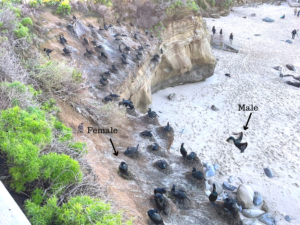Today, I would like to take a closer look into the elusive shorebird found on the coast of San Diego, Brandt’s Cormorant. This seabird, the largest cormorant species, is located only on North America’s Pacific Coast and feeds on the California Current. La Jolla is the best place to see Brandt’s Cormorants up close. I just happened to be in the area at the end of January this year and was pleasantly surprised to see a baby cormorant and two eggs!
The Brandt’s Cormorant is strictly marine but is known to enter San Diego Bay. It is fascinating that it does not enter Mission Bay or any of San Diego’s coastal lagoons. Their main colonies are on The Channel Islands of Southern California and Mexico’s Los Coronados Islands.
Let’s take a closer look at the Brandt’s Cormorant, shall we?
Table of Contents
Brandt’s Cormorants Characteristics
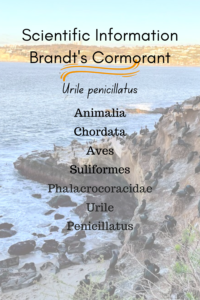
Identification
The Brandt’s Cormorant is a large, heavy-bodied, oval-shaped shorebird with a slender neck and hooked beak. The breeding adults are black with a purple sheen, have brilliant turquoise eyes, a very bright blue (gular pouch) throat patch, which fades after the breeding seasons, and whiskery white feathers on the head, neck, and shoulders.

Nonbreeding birds are entirely black, and the juveniles are dark brownish with a fluffy plume around the neck.
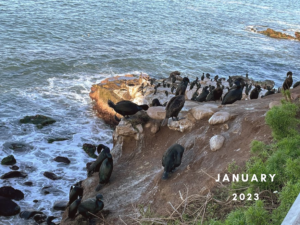
The bird was named after the German zoologist Johan Friedrich von Brandt in 1837.
The name Cormorant is derived from the Latin words Corvus Marinus, which translates to marine crow or raven. Some believe this is due to their perching behavior on bluffs or cliffs beside the ocean.
Size
The size of the Brandt’s Cormorant falls between a crow and a goose for comparison in the world of birds, with both sexes being similar in size.
- length – 27.6 to 31.1 inches
- weight – 49.4 to 95.2 ounces (1400 to 2700 grams)
- wingspan- 42.5 inches
Life Cycle
Lifespan is a maximum of 25 years with an average of 15 years and reaches sexual maturity at two years. They return to the breeding colony at two years but do not start mating until three to four years old.
Chicks are born without feathers and rely on regurgitation from their parents for the first month of life.
The Sexual Cycle of the Brandt’s Cormorant

The sexual cycle of Brandt’s Cormorant can be broken up into three different phases:
- Advertising males with visiting females
- Pairing up temporary or permanent with both male and female displaying to each other (bisexual displays)
- Egg laying and rearing
Advertising Males- Phase One
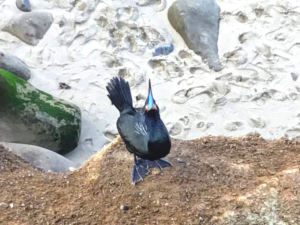
Phase One begins when the males advertise by ‘displaying’ and the females by visiting the males.
-
- The males will pick out the nesting spot and display it to attract females and defend their territory.
- Males will take up a position as their territory even before finding an m. In contrast, while the males are ‘displaying,’ females will walk amongst them, all the while up stretching their necks, looking at all of the males advertising, trying to figure out whom they will choose- as a female approaches, the male displays will intensify.
- The Flutter-Displays include first squatting with the breast touching the ground, extending the throat patch (gular) by putting its head back and pointing its beak upwards, spreading the tail feathers, and fluttering its wings while also thrusting the head forward and downward. This Flutter display may be done for up to 25 seconds before the second part of the display- The Stroke is made.
- The Stroke – Displays include putting the wings partly on the back, and then the head is thrust forward and downwards like a hammer. A slightly opened beak will contact the rock ledge, the gular pouch stays distended, and the head, neck feathers, and white filaments are fluffed out, looking like a swollen neck. Males will do this up to 15 times before reverting to The Flutter.
Making a Choice- Phase Two
Phase Two begins when a female chooses a male, either by flying or walking up to him, and this is when they will both start displaying to each other (bisexual displays.)
This is the phase where pairing will either take place or not. If pairing is not accomplished, the male will resume displaying to other females, and the female will go off searching for another male, but if the female chooses the male, he will stop displaying.
The male goes off searching for nesting material if any female stays with him for any time. Most of the nesting material is acquired underwater.
When the male returns with the nesting material, the female will get up from sitting and take hold of the material in her bill.
The males and females will hold the material in their beaks together, sway side to side and place the nesting material down in tandem.
Brandt’s Cormorant Breeding
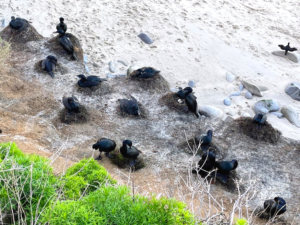
- breeds all along the Pacific Coast from Alaska down to Mexico; with the main breeding grounds from Washington down to California
- nest in dense colonies on the ground, along cliffs, islands, and offshore rocks: prefers the windward side of islands, either level or steeply sloped
- the males pick out the nesting site and will stay there to ward off rivals and bring nesting materials to the females, and she will build the nest
- produce a clutch of 3 to 6 white to light blue eggs
- incubation time= unknown
- male and female parents will brood the newly hatched chicks for five to ten days until the downy feathers appear
- both parents feed the chicks by regurgitation
- chicks learn to fly (fledge) at 25 to 40 days
The Brandt’s Cormorant’s Nest and Territory
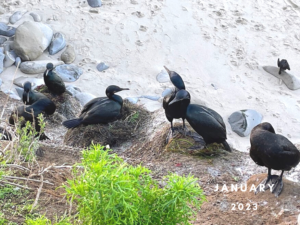
The nest is a circular mound of grass, seaweed, sticks, and other materials cemented together by their droppings (guano.) Both the male and female will constantly arrange this nest throughout the incubation period of the chicks.
The nest measures 13 to 14 inches long and 6 inches tall, with the interior of the nest being around 7.8 inches across and 3.5 inches deep.
Brandt’s Cormorant Feeding Behavior
- Pursuit diving -searches for food close to shore by diving in ocean areas where upwellings bring nutrients to the surface- dive up to 150 feet below the surface with the help of webbed feet
- forages by diving and swimming underwater, catching prey by luring it up to the surface and then grasping it within its beak
- diet includes rockfish, herring, shrimp, and crabs
- often forages with other seabird species and sometimes with marine mammals
- feed less often in estuaries and bays
- rarely seen more than 10 miles from shore unless migrating
Brandt’s Cormorant Nesting in La Jolla History
The Brandt’s Cormorant occurs in San Diego County as a winter visitor, but some will remain yearly. They have nestled on the bluffs above the La Jolla Caves and were first noted in 1933. At that time, it was considered to be a long-established breeding colony. They nest on ledges on cliffs or inside caves.
The nesting in La Jolla is unsynchronized, as there are reports of nests being built that occurred as early as December and as late as April. There were two studies done in the early 2000s that reported occupied nests from February to July.
This makes sense why there were already chicks and eggs during my visit.
Where Does the Brandt’s Cormorant Hangout in San Diego?
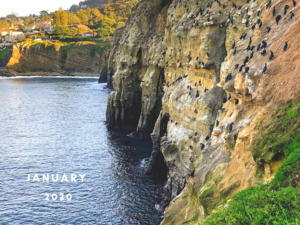
The Brandt’s cormorant is exclusively marine and prefers to be on the windward side of islands, coastal cliffs, and offshore rocks.


In closing, I wanted to give some final thoughts regarding the Brandt’s Cormorant breeding colony at La Jolla Cove. I observed that all breeding adults were concentrated near and around the nesting area, while nonbreeding and juveniles were off to the side closest to the water.
I highly recommend visiting La Jolla Cove and checking them out for yourself! And while you are there, see the California sea lions (around the corner) and the Pacific Harbor seals at La Jolla Children’s Pool!
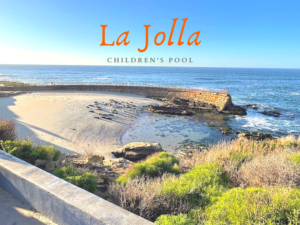
More Interesting Brandt’s Cormorant Facts!
- The breeding colony here in La Jolla is the only one on mainland Southern California, south of Santa Barbara.
- When chicks are a little bit older, and the parents are not attending the nest, they will assemble into little groups called- crèches but return to their nests to be fed.
- Mating pairs use the same nest year after year, adding more material each year.
- There are over 4200 mating pairs of Brandt’s Cormorants located on the islands of Channel Islands National Park.
- Nonbreeding birds are seen on the San Diego County coast from La Jolla to the south in the summer.
- In North San Diego Bay, the Brandt’s Cormorant is the second most popular shorebird, after the Heerman’s Gull; it is relatively common in Central San Diego Bay but absent in South San Diego Bay
- they are seen migrating between Point Loma and the Los Coronados Islands
- La Jolla Cove is home to two marine breeding colonies: California sea lion and Brandt’s Cormorant.
- They can hold their breaths for up to three minutes when diving for food and dive down to 230 feet, but 40 feet or so is average.
- Unlike other Cormorant species, the Brandt’s Cormorant doesn’t spend much time holding a spread-winged posture to dry the wings or perch in trees
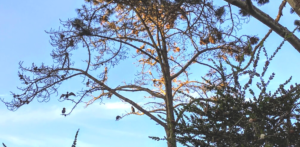
Helpful Posts–
- Best San Diego Birding Hotspots
- Showcasing the Best Beaches in La Jolla
- Checking Out the California Sea Lions in La Jolla
- The Western Snowy Plover- A Closer Look
Resources–
- Brandt’s Cormorant Identification, All About Birds, Cornell Lab of Ornithology
- Brandt’s Cormorant – Channel Islands National Park (U.S. National Park Service) (nps.gov)
- San Diego County Bird Atlas (sdsu.edu)
- Brandt’s Cormorant | Audubon Field Guide
- Sea Wonder: Brandt’s Cormorant | National Marine Sanctuary Foundation
- viewcontent.cgi (humboldt.edu)

I have always had a deep-seated passion for the Ocean Environment which ultimately led me to receive a degree in Marine Biology. Living in the San Diego area for over 30 years, I have extensively explored the 70 miles of San Diego’s coastline, and I am here to share! Please use my website to your advantage and have a look around at all the wonders that the beaches of San Diego can offer you!


